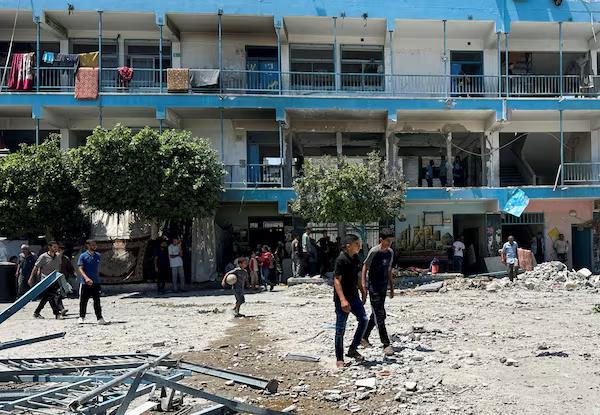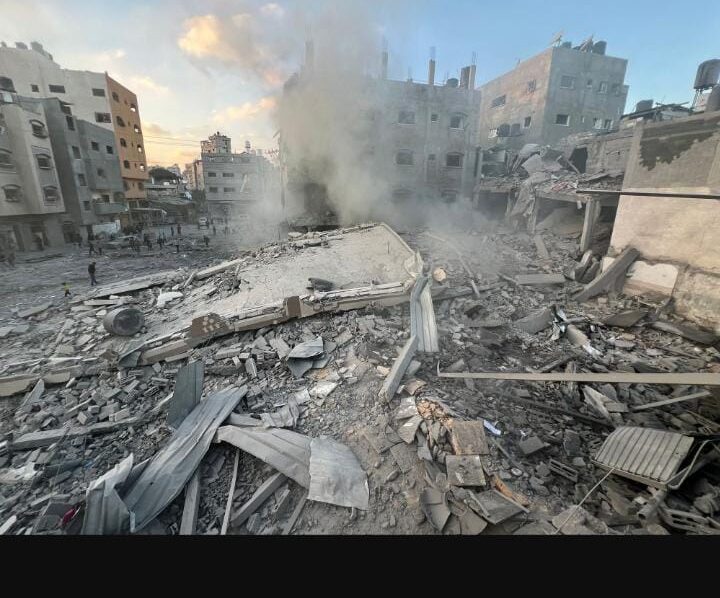
In a devastating turn of events, an Israeli airstrike on a Gaza school has resulted in significant casualties. The incident, occurring at a United Nations (UN) school in Nuseirat, has intensified the already severe conflict between Israel and Hamas.
The Airstrike and Its Aftermath
- Details of the Strike: On Thursday, Israel launched an airstrike on a Gaza school, claiming it targeted and killed Hamas fighters sheltering within the UN-run facility. The Israeli military released satellite images purportedly showing the specific areas where Hamas fighters were located.
- Casualties Reported: According to Ismail Al-Thawabta, director of the Hamas-run government media office, the strike killed 40 people, including women and children. The UN Palestinian refugee agency (UNRWA) could not confirm the death toll but acknowledged that the school might have been hit multiple times.
- Israeli Justification: Israel’s military spokesperson, Lt Col. Peter Lerner, stated that the strike was conducted based on reliable intelligence indicating the presence of 20-30 Hamas and Islamic Jihad fighters in the compound. Lerner asserted, “We’re very confident in the intelligence,” and claimed the military took steps to protect civilians.
Reactions and Responses
- Hamas’ Denial: Hamas officials refuted Israel’s claims, with Al-Thawabta accusing Israel of using fabricated stories to justify the attack. Hamas maintains that the school was not used as a command post.
- International Concerns: The U.S. embassy in Beirut reported a shooting near its entrance earlier, raising tensions further. Diplomatic efforts continue to address the violence, with CIA Director William Burns meeting officials from Qatar and Egypt to discuss ceasefire proposals.
Broader Conflict Context
- Ongoing Violence: The airstrike is part of a larger Israeli military campaign in Gaza, which Israel says targets Hamas fighters using insurgency tactics. This conflict has resulted in significant casualties, with health officials in Gaza reporting over 36,000 deaths since the conflict began.
- Ceasefire Efforts: Despite numerous attempts to broker a ceasefire, fighting has persisted. U.S. President Joe Biden has called for an end to the aggression, but both sides remain entrenched in their positions. Hamas has rejected ceasefire plans that do not include a permanent end to the war.
- Political Implications: The conflict has significant political ramifications for Israeli Prime Minister Benjamin Netanyahu, who faces pressure both domestically and internationally to negotiate a ceasefire and secure the release of Israeli hostages held by Hamas.
The Human Toll
- Civilian Suffering: The latest strike highlights the severe impact of the conflict on civilians. Displaced individuals seeking refuge in the UN school became casualties in the ongoing violence. The humanitarian crisis in Gaza continues to deepen, with thousands of lives lost and countless others disrupted.
Moving Forward
- International Mediation: Efforts by international mediators, including U.S. involvement, are crucial in seeking a resolution to the conflict. However, achieving a sustainable peace remains a formidable challenge given the deep-seated hostilities and political complexities.
As the world watches, the need for a diplomatic solution becomes ever more urgent to prevent further loss of life and to bring lasting peace to the region.
Related Articles
Israeli Airstrike on Rafah Kills 12 Palestinians, Gaza Medics Say
Israeli Airstrike on Rafah Tent Camp Sparks International Outcry
Israeli Army Raids West Bank’s Jenin: Seven Palestinians Killed
Explainer: South Africa’s Genocide Case Against Israel at the ICJ
Israeli Airstrike on Rafah Refugee Camp: Tragedy Strikes Innocent Lives
Israeli Strike Kills Hezbollah Commander in Lebanon
Israel Approves Humanitarian Measures Following U.S. Pressure
Subscribe to Follow Global Trends for daily global news
Make Money Online Working Remotely
To Advertise, send a mail to advertise@followglobaltrends.com
Find Out How To Make Money As A Full Time Writer/Blogger
Written By : Joe Brens


